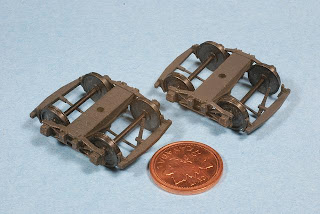 |
| This HO scale passenger car was printed in a 3D printer. |
I have seen the future of model railroading, and it is 3D printing. Well, it’s one aspect of the hobby’s future, at least.
For those of you unfamiliar with the concept—as I was until my new friend, Jeff, a 3D printing jewelry designer explained it to me—3D printing is a way to design objects on a computer, send the design to a company with a 3D printer, then have that company print the object and mail it to you.
 |
| Need a pilot for your steam locomotive? 3D print it! |
Through 3D printing (also called rapid prototyping), modelers can make unique items that are unavailable as commercial products—a CN style wheel stop, a 1950s-style oil drum, or detail parts like horns, handrails, bells, domes, windows, etc.
 |
| Need a dumpster on your layout? Print it! |
How does it work? It’s a mystery to me, but Jeff tells me that it’s an additive manufacturing technology where three dimensional objects are created by laying down successive layers of material. These materials can be plastic, ceramics, glass or stainless steel.
 |
| You can even make buildings, like this Z scale engine house. |
Items are available in a variety of scales, from T to HO. The larger an object is, the more expensive it is, since it requires more material and time to make it.
For the smaller scales, like T, Z and N, 3D printing can make complete models—rolling stock, locomotives and buildings. For larger scales, it seems best suited for detail parts like fire hydrants, garbage cans and the like.
 |
| Or maybe you need a shopping cart . . . |
Of course, you need considerable computer design skills to make these items—or just need to be under the age of 30, since youth today seemingly can figure out almost any new technology (unlike old guys like me).
Luckily, lots of these smarter and younger people will make 3D printable items for you—all you need to do is send them a photo of what you want, and they will design and print it. Once designed, it can then be sold to others who might also need that particular item, allowing you to pay off the cost of making it, and maybe even make a few bucks.
 |
| How about a garbage can? |
Speaking of costs, 3D printing isn’t cheap. On the other hand, it is a lot less expensive than the traditional injection molded manufacturing process, which requires a considerable up-front investment of thousands of dollars, along with the need to make hundreds or thousands of parts to recoup your investment.
Jeff tells me that, just like with other technologies, the cost will go down. Who knows? Maybe one day there will be no more limited production runs, with the need to buy now or lose. If you want a GP9 that is accurate for your prototype, with all the louvres and doors and fuel tanks in the right place, you can just order one of them and have it delivered to your door.
 |
| This 3D printed cart is really cool. |
One of the leaders in the world of 3D printing is Shapeways. If you go to their website, and search for “model railroad,” you will find dozens of pages offering items (such as pictured in this post.)
 |
| With 3D printing you can turn this . . . |
 |
| Into this. |
My friend Jeff tells me that, one day, we all might have 3D printers in our homes—an outlandish thought, until you remember that it wasn’t so long ago that the idea of everyone having a personal computer was crazy, too.
 |
| A design for a Z scale car. |
But don’t take my word for it. Here’s what The Economist magazine said in the Feb. 10, 2011 issue:
“Three-dimensional printing makes it as cheap to create single items as it is to produce thousands and thus undermines economies of scale. It may have as profound an impact on the world as the coming of the factory did . . . just as nobody could have predicted the impact of the steam engine in 1750—or the printing press in 1450, or the transistor in 1950—it is impossible to foresee the long-term impact of 3D printing. But the technology is coming, and it is likely to disrupt every field it touches.”
Including model railroading.
 |
| Appropriately, a 3D printed Nn3 caboose brings this post to an end. |
Shapeways and other rapid prototype 3D printing technologies still have some growing up to do it would seem. For functional pieces, like trucks and couplers, I feel the material coming out of these printers is still a little on the brittle side. For non-functional pieces, such as detail parts, the resolution still isn't there. Parts frequently have a texture to them or visible "print lines". Over time I suspect these kinds of issues will probably get ironed out.
ReplyDeleteI spent a decent portion of this past year messing around with Shapeways and have overall not been very satisfied with them for model railroad applications. There have been a couple niche pockets that have had some success, like the Z-scale guys you mentioned, but there needs to be some improvements before this becomes a really useful tool for model railroaders.
Here's an example of some of my test prints and thoughts about the quality: http://somerailroad.blogspot.com/2011/07/some-3d-printed-models.html
Thanks for sharing this great content, I really enjoyed the insign you bring to the topic, awesome stuff!
ReplyDeletecheap print
Fabulous collection of printing! But how do you do that that becomes 3D? is there a software that you used before printing?
ReplyDeleteThese are very interesting facts covered on this blog.
ReplyDelete3d printing service cost
3d printing products
Best Desktop 3D Printers
3d printer material
3d photo printing